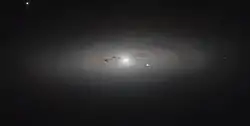NGC 4036
NGC 4036 is the New General Catalogue identifier for a lenticular galaxy in the northern circumpolar constellation of Ursa Major. In the Carnegie Atlas of Galaxies, it is described as being "characterized by an irregular pattern of dust lanes threaded through the disc in an 'embryonic' spiral pattern indicating a mixed S0/Sa form."[4] It is located near the Big Dipper, a little to the north of the mid-way point between the stars Alpha Ursae Majoris and Delta Ursae Majoris. With a visual magnitude of 10.7, it can be dimly viewed using a 4 in (10 cm) aperture telescope.[6]
| NGC 4036 | |
|---|---|
 Image of NGC 4036 taken by the Hubble Space Telescope | |
| Observation data (J2000 epoch) | |
| Constellation | Ursa Major |
| Right ascension | 12h 01m 26.891s[1] |
| Declination | +61° 53′ 44.52″[1] |
| Redshift | 0.004817[2] |
| Helio radial velocity | 1,445[2] km/s |
| Distance | 62.1 Mly (19.04 Mpc)[3] |
| Group or cluster | LGG 266[4] |
| Absolute magnitude (V) | 10.66[4] |
| Characteristics | |
| Type | S0−[3] |
| Apparent size (V) | 2.703′ × 1.027′[1] |
| Other designations | |
| 2MASX J12012689+6153445, IRAS 11588+6210, LEDA 37930, UGC 7005, UZC J120126.7+615345, Z 292-59[5] | |
The visual dimensions of this galaxy are 2.703 × 1.027[1] arc minutes, with the major axis having a position angle of 85°.[4] The galaxy is being viewed nearly edge-on, with an inclination of 18° to the line of sight from the Earth.[7] It is moving away from us with a heliocentric radial velocity of 1,445[2] km/s. The estimated visual luminosity of the galaxy is 4.2×1010 L⊙, or 42 billion times the brightness of the Sun. Photographs show a tightly wound spiral pattern in the galactic disk, with three dust lanes—the southern side of the galaxy appears dimmer due to the dust configuration.[7] The mass of the free gas and dust in the galaxy is about 1.7×109 M⊙ and 4.4×105 M⊙, respectively, with around 7×104 M⊙ of the gas being in an ionized state.[4]
This is a type of active galaxy known as a LINER, which means that it shows emission lines of ionized gas in the region of its nucleus. Chemically, the stars at the center of the nucleus have a higher metallicity than in the neighboring regions. It appears that there is a tilted disk of stars orbiting the nucleus within a radius of 820 ly (250 pc). The galactic bulge itself appears triaxial with the ionized gas concentrated near the center of this bulge region.[8] Images of the galaxy with the Hubble Space Telescope show a wispy disk of dust on all sides of the nucleus, with what appears to be the tendrilous remains of an ionization cone leading away 4 arc seconds to the northeast. Such features are common in Seyfert galaxies.[7]
On July 23, 2007, Type Ia supernova SN 2007gi was discovered by Koichi Itagaki near the central bulge of this galaxy.[9] It reached peak magnitude around August 14, then steadily declined in brightness thereafter. Materials identified in the spectrum included silicon, calcium, and sulfur moving outward at velocities of around 15,500 km/s. This is a 50% higher velocity than what is normally observed with supernovae of this type.[10]
NGC 4036 is a member of the LGG 266 galaxy group, along with NGC 4041, IC 758, UGC 7009, and UGC 7019. It is located just 17 arc minutes from NGC 4041, and the two form a pair with a projected separation of around 470 kly (143 kpc).[4]
References
- Skrutskie, M. F.; et al. (February 2006), "The Two Micron All Sky Survey (2MASS)", Astrophysical Journal, 131 (2): 1163–1183, Bibcode:2006AJ....131.1163S, doi:10.1086/498708.
- Kochanek, C. S.; et al. (October 2001), "The K-Band Galaxy Luminosity Function", The Astrophysical Journal, 560 (2): 566–579, arXiv:astro-ph/0011456, Bibcode:2001ApJ...560..566K, doi:10.1086/322488, S2CID 119420446.
- de Vaucouleurs G.; et al. (1994), "Third Reference Catalogue of Bright Galaxies (RC3)", The Astronomical Journal, 108: 2128, Bibcode:1994AJ....108.2128C, doi:10.1086/117225, retrieved 2015-11-16.
- Cinzano, P.; et al. (August 1999), "The kinematics and the origin of the ionized gas in NGC 4036", Monthly Notices of the Royal Astronomical Society, 307 (2): 433–448, arXiv:astro-ph/9903216, Bibcode:1999MNRAS.307..433C, doi:10.1046/j.1365-8711.1999.02617.x, S2CID 119466666.
- "NGC 4036". SIMBAD. Centre de données astronomiques de Strasbourg. Retrieved 2015-11-16.
- O'Meara, Steve (2007), Herschel 400 Observing Guide, Cambridge University Press, p. 102, ISBN 978-0521858939.
- O'Meara, Stephen James (2011), Deep-Sky Companions: The Secret Deep, 4, Cambridge University Press, pp. 214–215, ISBN 978-1139500074.
- Sil'chenko, O. K.; Vlasyuk, V. V. (January 2001), "A Chemically Decoupled Nucleus and Structure of the Nuclear Region in the S0 Galaxy NGC4036", Astronomy Letters, 27: 15–24, Bibcode:2001AstL...27...15S, doi:10.1134/1.1336857, S2CID 54607256.
- Harutyunyan, A.; et al. (August 2007), Green, D. W. E. (ed.), "Supernova 2007gi in NGC 4036", Central Bureau Electronic Telegrams, 1021: 1, Bibcode:2007CBET.1021....1H.
- Zhang, T.; et al. (January 2010), "Optical Observations of the Rapidly Expanding Type Ia Supernova 2007gi", Publications of the Astronomical Society of the Pacific, 122 (887): 1–11, arXiv:0910.1913, Bibcode:2010PASP..122....1Z, doi:10.1086/649851, S2CID 118517321.